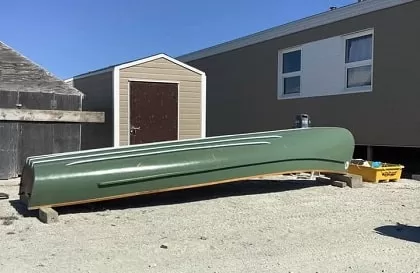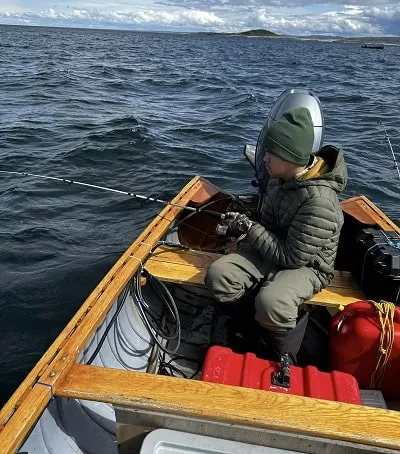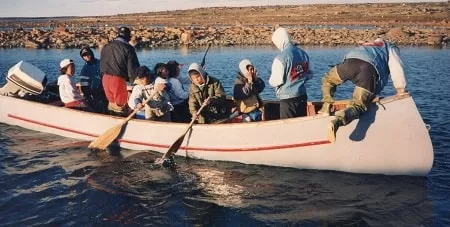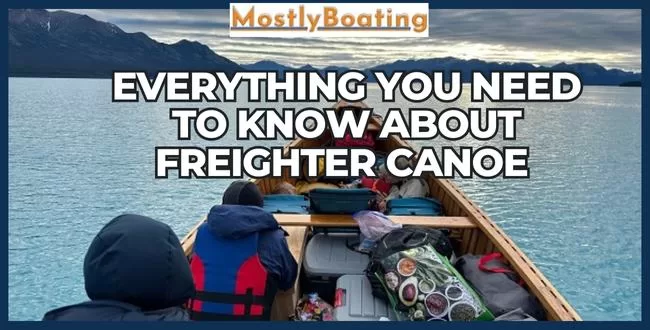An outdoor enthusiast looking for a reliable, versatile watercraft that can handle various conditions and activities? Freighter canoes are the best option for you.
These unique boats are designed for carrying cargo and are perfect for various uses, from leisurely excursions to hauling gear on wide, easy-flowing rivers.
With a wide beam and stable hull design, freighter canoes can be paddled, rowed, or equipped with a motor, making them a versatile choice for any water adventure. As per our experiences, we have found Cargo Canoes to be agile and efficient in rough waters.
This blog post comprehensively explores the history, uses, purchasing tips, and popular models of freighter canoes, making it a valuable resource for you.
Key Takeaways About Freighter Canoe
What is a freighter canoe – A freighter canoe is a versatile watercraft designed for carrying heavy loads and transporting cargo. It can be paddled, rowed, or equipped with a motor and can navigate through shallow waters.
Historical Background of Cargo Canoes – Freighter canoes were used during the fur trade era as efficient highways for travel. They were designed for carrying heavy loads and transporting cargo through shallow waters and used to be around 26 feet. The wood and canvas Cargo Canoes is an iconic example of historic canoe craftsmanship.
Applications of Freight Canoe – Freighter canoes can be used for various purposes, including excursions or hauling on wide, easy-flowing rivers, carrying large loads through very little water. They can be paddled, rowed, or equipped with a motor.
What’s the price of a used/new freighter canoe- A used freighter canoe costs around $750, while a new one costs approximately $1,500. However, prices vary depending on quality, materials, and specific models.
What is a freighter Canoe?
A freighter canoe is a versatile watercraft that handles various conditions and activities. It is known for its stability and ability to carry heavy loads, making it suitable for transportation, hunting, and fishing in shallow water environments.
| Canoe Type | Purpose | Length | Width | Hull Shape | Capacity | Stern Shape |
|---|---|---|---|---|---|---|
| Freighter Canoe | Carrying heavy loads and transporting cargo | 16-26 feet | Wide beam | Stable hull design | High | Square stern |
| Recreational Canoe | Leisurely paddling and general recreational use | 12-16 feet | Moderate width | Symmetrical hull shape | Moderate | Pointed stern |
| Racing Canoe | Competitivee racing and water sports | Long and sleek | Narrow beam | Pointed, narrow bow and stern | Low | Pointed stern |
| Solo Canoe | Paddled by one person | Within 10 feet | Small size | Seat positioned halfway between bow and stern | Low | Pointed stern |
| Tandem Canoe | Can easily carry two or multiple persons | Over 15 feet | Longer depending on seating capacity | Symmetrical hull shape | Moderate | Pointed stern |
Design and Construction of Freight Canoes
Hull Shape and Material
Freight canoes typically have a wider and more stable hull design to accommodate heavy loads and provide stability in rough waters.
The material used for the hull can vary, but common options include wood, fiberglass, and aluminum. Wood can provide a traditional and aesthetically pleasing look, while fibreglass and aluminium offer durability and resistance to damage.

Size and Capacity
Freight canoes are larger than recreational canoes to accommodate larger loads. They are typically longer and wider than standard canoes.
The capacity of a freight canoe depends on its size and design. The average weight limit of a 14 ft. canoe is 700 pounds, while a 16 ft. canoe can hold an average of 940 pounds.
Customization and Modifications
Freight canoes can be customized and modified to suit specific needs and preferences like adding seats or some storage compartments.
Some manufacturers offer customizable options for freight canoes, allowing customers to choose specific features, materials, and finishes to meet their requirements.
It is also common for individuals to modify their freight canoes themselves, such as adding reinforcement to the hull or installing specialized equipment for specific purposes.
Uses and Applications of Freight Canoes
Cargo Transportation
Freight canoes are designed to carry heavy loads and are commonly used for cargo transportation.
- Freight canoes have been used to haul fur and other goods for trading for a very long time.
- The square stern Cargo canoe is designed for carrying large loads and is light and maneuverable.
- Freight canoes can carry a large load through very little water, making them ideal for use in shallow rivers and lakes.

Exploration and Expedition
Freight canoes are also used for exploration and expedition purposes. They are ideal for navigating through remote areas and can be used to reach places that are not accessible by other means of transportation.
- Historically, freight canoes were used for excursions or hauling cargo on wide, easy-flowing rivers.
- Freight canoes can be used for wilderness expeditions and camping trips, allowing paddlers to carry all the necessary gear and supplies.
- Freight canoes can be used for scientific research and exploration in remote areas.
Fishing and Hunting
Freight canoes are also popular among anglers and hunters. They are ideal for accessing remote fishing and hunting spots and can be used to carry gear, canoeing accessories and equipment.
- The Heron maine freighter canoe is multi-purpose, perfectly adapted to fishing and hunting.
- Freight canoes can be used as a drift boat for fly fishing or paddled/rowed for trolling.
- Freight canoes can be used for hunting trips, allowing hunters to access remote areas and carry their gear and equipment.

Stability and Maneuverability in Cargo Canoes
Stability:
- Width and cross-sectional shape: A wider canoe generally has more initial stability, making it less likely to tip over. On the other hand, narrower canoes tend to have less initial stability but offer better secondary stability, which means they are more stable when tilted to one side.
- Hull shape: Canoes with a flat-bottomed hull provide more initial stability, while those with a rounded or V-shaped hull offer better secondary stability and maneuverability.
- Load distribution: Placing the cargo low and evenly distributed helps maintain stability and prevents the canoe from becoming top-heavy.
Maneuverability:
- Keel-line: A straight keel line from stem to stem produces a fast and easy-paddling canoe, while a curved or rocker keel line enhances maneuverability, allowing the canoe to turn more easily.
- Length: Longer canoes tend to track straighter and have better stability at higher speeds, but they may be less maneuverable in tight spaces. Shorter canoes are more maneuverable but may sacrifice some tracking ability.
- Weight: Lighter canoes are generally easier to maneuver, especially in tight or winding waterways, while heavier canoes may require more effort to turn and maneuver.
Things to Check in a Freighter Canoe Before Purchasing
Before purchasing a Cargo Canoe, there are several important things to check to ensure you get a high-quality and reliable watercraft.
Material:
Checking the quality and condition of the material is crucial to avoid potential structural weaknesses, reduced lifespan, and increased maintenance requirements.
Hull condition:
Inspecting the hull for cracks, dents, or repairs is essential to ensure the canoe’s integrity and buoyancy.
Weight capacity:
Determine the weight capacity of the canoe and ensure that it meets your specific needs. Exceeding the weight capacity can affect the canoe’s stability, maneuverability, and safety. For safety purposes, you must use canoe life jackets, or also know how to right a tipped canoe, to be prepared for every emergency situation.
Reputation and reviews:
Researching the brand, manufacturer, or seller can provide insights into the canoe’s quality and reliability.
Paddling Techniques and Skills for Freight Canoes
Paddling in a normal canoe is generally more maneuverable, while paddling in a freighter canoe is designed for stability and carrying heavy loads.

- The J-stroke:
The J-stroke involves a combination of a forward stroke and a correction stroke, which allows the canoe to turn slightly while maintaining forward momentum and is useful for navigating through narrow channels or in windy conditions.
- Forward Stroke:
The forward stroke is the most basic and essential canoeing stroke. It involves a simple forward motion of the paddle, propelling the canoe forward. The forward stroke is useful for general paddling and maintaining a steady course.
- Back Stroke:
The backstroke moves the canoe backward and involves a simple backward paddle motion, propelling the canoe in the opposite direction. The backstroke is useful for reversing direction or slowing down the canoe.
- Draw stroke:
The draw stroke involves pulling the paddle towards the canoe, creating a sideways force that moves the canoe in the desired direction. The draw stroke is useful for steering the canoe in tight spaces or avoiding obstacles.
- Pry stroke:
The pry stroke turns the canoe in the opposite direction of the paddle, and the stroke involves pushing the paddle away from the canoe, creating a turning force that moves the canoe in the desired direction. The pry stroke is useful for making sharp turns or navigating through narrow channels.

Popular Models and Manufacturers of Freight Canoes
- Great Northern Freighter Canoe: Manufactured by Sandy Point Boat Works, designed for excursions or hauling on wide, easy-flowing rivers.
- Timber BoatWorks: Offers versatile maine freighter canoe that can be paddled, rowed, or used with a motor.
- Buffalo Canoes Manufacturing: Produces the Buffalo T-Formex freighter canoe known for durability and ability to carry large loads through shallow waters.
- Pakboats/ScanSport, Inc.: Manufactures the PakCanoe 170, a folding freighter canoe offering portability and versatility.
- Wenonah Canoe, Inc: Offers a range of canoes, including tandem models suitable for freight purposes
- Nova Craft Canoe: Reputable manufacturer with durable tandem canoes suitable for freight purposes.
Comparison of Cargo Canoe with Jon Boats, Dories, and Other Cargo Boats
Freighter Canoes:
- Designed specifically for carrying heavy loads and transporting cargo.
- Wide beam and stable hull design for better stability and weight distribution.
- It can be paddled, rowed, or equipped with a motor.
- Versatile and can be used in various water conditions, including shallow and rough waters.
- Often described as the workhorse of the north, freighter canoes can carry a large load through very little water.
Jon Boats:
- Wide beam and shallow draft for use in shallow waters.
- Their wide and flat design can carry a lot of cargo.
- They may not have the same stability as Cargo Canoe in rough waters.
- Jon boats are a clear winner regarding available cargo space.
Dories:
- Traditional fishing boats with a narrow, pointed shape.
- Designed for use in open water and can handle rough conditions.
- High-weight capacity and can carry a lot of cargo.
- They may not be as stable as freighter canoes in calm waters.
Barge Boats:
- Large, flat-bottomed boats are used to transport bulk cargo.
- High-weight capacity and can carry a large amount of cargo.
- They are less maneuverable or versatile than Cargo Canoe, especially in shallow or narrow waterways.
Workboats:
- Boats are designed for specific work purposes, such as towing, dredging, or construction.
- Can carry cargo and equipment for specific work purposes.
- They are less versatile than maine freighter canoe and may not be suitable for general cargo transportation.
Commercial Cargo Vessels:
- Large ships are designed to transport bulk cargo over long distances.
- High-weight capacity and can carry a large amount of cargo.
- Not suitable for shallow or narrow waterways and may not be as versatile as freighter canoes.
FAQs
What’s the price range of Freighter Canoe?
Used freighter canoes cost around $3,000, while new ones can start from $2,000 and go up. However, some specialized models, such as the 20′ Grumman Canoe, can cost more, priced at $2,500.
Are Cargo Canoe good for long-distance travelling?
Yes, freighter canoes are good for long-distance travel. Their stability and versatility make them suitable for covering long distances while carrying a large load.
What’s the average speed of freighter canoes?
Average canoe speed of freighter vessels around 10 to 15 knots.
What are the typical dimensions of a Cargo Canoe and its weight limit/seating capacity?
Freight canoes are typically longer and wider than standard canoes, varying dimensions depending on the specific model.
The weight limit of a canoe depends on factors such as length, width, materials, and manufacturer. The average weight limit of a 14 ft. canoe is 700 pounds, while a 16 ft. canoe can hold an average of 940 pounds.
Is attaching trolling motor with a cargo canoe a must?
Attaching a canoe trolling motor to a cargo canoe is not a must, but it can be a beneficial addition for certain situations, like saving energy and making fishing more convenient without spooking the fish.
How do freighter canoes handle rough water conditions, such as choppy waves or strong currents?
Freight canoes are known to handle rough water better than jon boats and are great in rough water conditions. The stability of large freighter canoes allows for the efficient use of mud motors in rough water conditions.

Jack Bennett, a passionate pedal boating enthusiast, and marine engineer by day, is here to share my knowledge and love for this exciting sport with you all. Happy Boating!
